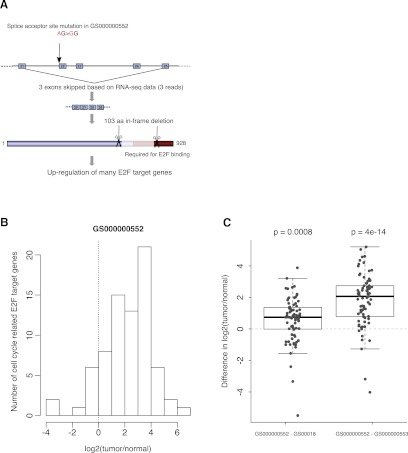Figure 3.
Splice mutation in RB1 and the associated aberrant splicing event. (A) Splice site mutation is associated with an exon skipping event in RB1 in the tumor genome GS000000552. A novel mutation in the tumor suppressor gene RB1 alters the AG essential splice acceptor sequence just before exon 22. There are three RNA-seq reads spanning a novel exon–exon junction between exons 21 and 25, skipping the three exons in between. The resulting protein product has a 103-amino-acid in-frame deletion close to the C terminus of RB1, which is essential for the binding of RB1 to the E2F–DP transcription factor complexes. (B) Most cell cycle-related E2F target genes (Bracken et al. 2004) are up-regulated in sample GS000000552. For each gene, we obtained the expression values in matched normal and tumor samples from the patient, and calculated the log2 fold-change between tumor and normal. (C) Among the three tumor samples, E2F target genes are up-regulated the most in sample GS000000552. Each dot represents one of the known cell cycle-related E2F target genes (Bracken et al. 2004). P-values shown on the plot are derived from paired t-tests between GS000000552 and one of the other tumors. The result is consistent with the hypothesis that the truncated RB1 in this sample resulting from aberrant splicing is unable to bind to E2F and suppress the expression of its target genes. The boxes in the box-and-whisker plots represent the interquartile range between the first and third quartiles; the dashed lines (whiskers) extend to the most extreme data points which are no more than 1.5 times the interquartile range from the box.

